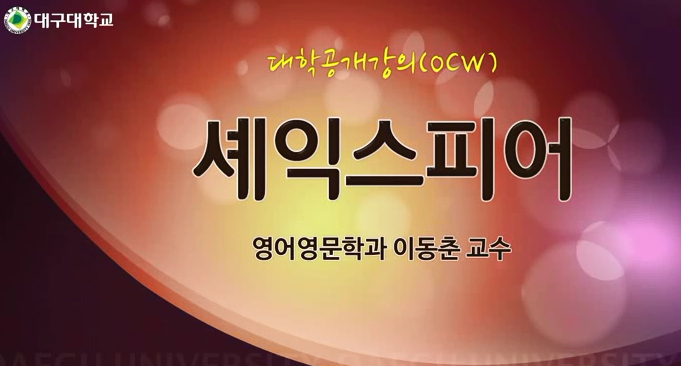이 글은 국립극단의 ‘삼국유사 프로젝트’ 공연작품 중 두 편을 중심으로 신화와의 상호텍스트성과 신화의 재해석 문제, 신화 다시쓰기 방식과 신화의 현재화를 중심으로 살펴보고자 했다...
http://chineseinput.net/에서 pinyin(병음)방식으로 중국어를 변환할 수 있습니다.
변환된 중국어를 복사하여 사용하시면 됩니다.
- 中文 을 입력하시려면 zhongwen을 입력하시고 space를누르시면됩니다.
- 北京 을 입력하시려면 beijing을 입력하시고 space를 누르시면 됩니다.

‘삼국유사 프로젝트’ 연극에서의 신화 다시쓰기와 신화의 현재화-"꿈"과 "남산에서 길을 잃다"를 중심으로 = Myth Rewriting and the Presentization of Myth in the Plays of ‘Samkukyusa Project’ -Focusing on Dream and Lost in Namsan
한글로보기부가정보
국문 초록 (Abstract)
<꿈>의 신화 다시쓰기 방식에서 특징적인 것은 ‘조신의 꿈’을 전복하여 여러 층위의 인물들과 여러 인용문들을 직조하는 파편화 전략을 통해 ‘이광수의 꿈’을 제시했다는 점이다. 그러나 조신의 플롯과 이광수의 플롯은 ‘꿈’이란 공통성은 지니지만, 둘의 알레고리적 유비관계보다는 이질성이 두드러진다. 신화와 역사적 삶이 충돌하고, 신화적 세계관이 친일행위를 둘러싼 역사인식과 길항한다. ‘친일’이라는 극히 민감한 이슈가 극의 다층적인 의미구조와 신화적 상징들을 압도해버린 것이다.
<남산에서 길을 잃다>는 고대와 현대의 삶을 은유적 오버랩으로 구성하여, 산업화시대 노동자들의 희생과 꿈의 좌절이란 낯익은 서사에 신화적 아우라와 시적 상징성을 부여하고자 했다. 이 극은 과거와 현재가 서로를 참조하고, 현실과 환상이, 연극과 실재가 서로를 응시하게 만드는, 신화와 현대의 대화를 보여준다. 그러나 신화와 동시대 일상이란 서사의 두 층위를 유기적 극행동으로 교직한 게 아니라 독자/관객의 의미 해독의 틀을 규정하는 ‘자막’을 이용하는 도식적 방식으로 연결하고 있다.
신화에서 모티브를 가져와 작품을 쓴다는 것은 단순히 신화를 소재나 발상으로서 활용하는 것이 아니라, 신화의 의미와 구조, 세계관에 대한 깊이있는 분석이 선행되어야 하고, 동시대의 맥락에서 새롭게 재해석하고 변주하여 현대에 의미와 가치를 갖는 이야기로 재창조하는 것이다. 신화와 현대의 삶은 그 형상 면에서 엄청난 차이가 있지만 그 본질이나 의미구조 면에선 현대인의 삶도 신화적 세계의 등가물이라는 것을 그려 보일 때 신화의 현재화가 성취된다.
『삼국유사』의 신화 다시쓰기는 우리 사회가 공유하는 집단적 기억과 역사적 경험, 그리고 그 안에 집적되어 있는 문화적 기원과 상징적 표상을 현대적으로 재코드화 하는 작업이라 할 수 있다. 신화의 현재화는 신화를 동시대적 맥락과 관점으로 재해석, 재창조하는 방향을 가리키지만, 이것이 신화의 단순한 수용이나 변용, 그리고 현대적 의상과 언어, 생활상을 입혀 그리거나, 혹은 고대와 현대의 타임 슬립 장치 같은 표층적 차원을 의미하지 않는다. 국립극단의 ‘삼국유사 프로젝트’ 연극들 다수가 비판적 평가를 받았던 이유가 바로 신화의 현재화를 표층적 차원에서 이해하고 구현했기 때문이었다. 신화의 현재화는 고대 배경이든 현대 배경이든 간에 신화의 특성인 상징, 알레고리, 통과제의적 서사구조, 순환성, 원형 등을 서사의 맥락 속에 잠재적으로 담아내어 현대의 일상적 삶에도 여전히 신화가 지속되고 있음을 보여줄 때 성취되는 것이다.
이 글은 국립극단의 ‘삼국유사 프로젝트’ 공연작품 중 두 편을 중심으로 신화와의 상호텍스트성과 신화의 재해석 문제, 신화 다시쓰기 방식과 신화의 현재화를 중심으로 살펴보고자 했다.
<꿈>의 신화 다시쓰기 방식에서 특징적인 것은 ‘조신의 꿈’을 전복하여 여러 층위의 인물들과 여러 인용문들을 직조하는 파편화 전략을 통해 ‘이광수의 꿈’을 제시했다는 점이다. 그러나 조신의 플롯과 이광수의 플롯은 ‘꿈’이란 공통성은 지니지만, 둘의 알레고리적 유비관계보다는 이질성이 두드러진다. 신화와 역사적 삶이 충돌하고, 신화적 세계관이 친일행위를 둘러싼 역사인식과 길항한다. ‘친일’이라는 극히 민감한 이슈가 극의 다층적인 의미구조와 신화적 상징들을 압도해버린 것이다.
<남산에서 길을 잃다>는 고대와 현대의 삶을 은유적 오버랩으로 구성하여, 산업화시대 노동자들의 희생과 꿈의 좌절이란 낯익은 서사에 신화적 아우라와 시적 상징성을 부여하고자 했다. 이 극은 과거와 현재가 서로를 참조하고, 현실과 환상이, 연극과 실재가 서로를 응시하게 만드는, 신화와 현대의 대화를 보여준다. 그러나 신화와 동시대 일상이란 서사의 두 층위를 유기적 극행동으로 교직한 게 아니라 독자/관객의 의미 해독의 틀을 규정하는 ‘자막’을 이용하는 도식적 방식으로 연결하고 있다.
신화에서 모티브를 가져와 작품을 쓴다는 것은 단순히 신화를 소재나 발상으로서 활용하는 것이 아니라, 신화의 의미와 구조, 세계관에 대한 깊이있는 분석이 선행되어야 하고, 동시대의 맥락에서 새롭게 재해석하고 변주하여 현대에 의미와 가치를 갖는 이야기로 재창조하는 것이다. 신화와 현대의 삶은 그 형상 면에서 엄청난 차이가 있지만 그 본질이나 의미구조 면에선 현대인의 삶도 신화적 세계의 등가물이라는 것을 그려 보일 때 신화의 현재화가 성취된다.
『삼국유사』의 신화 다시쓰기는 우리 사회가 공유하는 집단적 기억과 역사적 경험, 그리고 그 안에 집적되어 있는 문화적 기원과 상징적 표상을 현대적으로 재코드화 하는 작업이라 할 수 있다. 신화의 현재화는 신화를 동시대적 맥락과 관점으로 재해석, 재창조하는 방향을 가리키지만, 이것이 신화의 단순한 수용이나 변용, 그리고 현대적 의상과 언어, 생활상을 입혀 그리거나, 혹은 고대와 현대의 타임 슬립 장치 같은 표층적 차원을 의미하지 않는다. 국립극단의 ‘삼국유사 프로젝트’ 연극들 다수가 비판적 평가를 받았던 이유가 바로 신화의 현재화를 표층적 차원에서 이해하고 구현했기 때문이었다. 신화의 현재화는 고대 배경이든 현대 배경이든 간에 신화의 특성인 상징, 알레고리, 통과제의적 서사구조, 순환성, 원형 등을 서사의 맥락 속에 잠재적으로 담아내어 현대의 일상적 삶에도 여전히 신화가 지속되고 있음을 보여줄 때 성취되는 것이다.
다국어 초록 (Multilingual Abstract)
What is special about the myth rewriting of Dream is Lee Kwang-Su's dream scene. It uses a fragmentation strategy that overturns the ‘Josin’s dream’ and weaves figures and quotes from different levels. This dream scene connects myths and history, and uses them as a symbol of the real world and history and as a symbolic model of the main narrative. However, Josin's plot and Lee's plot have the commonality of 'dream', but they are more heterogeneous than the allegorical analogy of the two. Myths and historical life clash, and mythical worldview antagonizes the historical perception of pro-Japanese activity. The extremely sensitive issue of ‘pro-Japanese’ overwhelmed the multi-layered semantic structures and mythological symbols.
Lost in Namsan consists of metaphorical overlaps between ancient and modern life, trying to give the mythical aura and poetic symbolism to the familiar narrative of sacrifice and frustration of dreams of workers in the age of industrial capitalism. This play presents the dialogue of myth and modern age in which the past and the present refer to each other, reality and fantasy, and the play and reality stare at each other. However, in the way of accepting myths, rather than reinventing mythological motifs and main narrative into organic structure, it used a simple way of connecting the narratives with modern narratives through the subtitles describing myth.
Taking motifs from a myth and writing a work does not simply use the myth as a material or an idea, but requires an in-depth analysis of the meaning, structure, and worldview of the myth. It is to recreate the story.
The presentization of myth goes beyond the simple acceptance or transformation of myths, and includes the mythical symbols, allegory, mythological narrative structure, cyclical worldview, and archetypes in the context of narrative, so that they can be appeared in modern everyday life. It shows that myths still persist.
Just as Samkukyusa contains myths, histories and fantasies, history is born from myth, history creates myth, and present life becomes one of myth someday.
In other words, the presentization of myth is achieved when the work embodies that modern life is equivalent to the mythical world.
This paper aims to examine two plays from the National Theater Company's ‘Samkukyusa(三國遺事) Project’ focusing on the intertextuality with myths, the reinterpretation of myths, the rewriting of myths, and the the presentization of myths. Wha...
This paper aims to examine two plays from the National Theater Company's ‘Samkukyusa(三國遺事) Project’ focusing on the intertextuality with myths, the reinterpretation of myths, the rewriting of myths, and the the presentization of myths.
What is special about the myth rewriting of Dream is Lee Kwang-Su's dream scene. It uses a fragmentation strategy that overturns the ‘Josin’s dream’ and weaves figures and quotes from different levels. This dream scene connects myths and history, and uses them as a symbol of the real world and history and as a symbolic model of the main narrative. However, Josin's plot and Lee's plot have the commonality of 'dream', but they are more heterogeneous than the allegorical analogy of the two. Myths and historical life clash, and mythical worldview antagonizes the historical perception of pro-Japanese activity. The extremely sensitive issue of ‘pro-Japanese’ overwhelmed the multi-layered semantic structures and mythological symbols.
Lost in Namsan consists of metaphorical overlaps between ancient and modern life, trying to give the mythical aura and poetic symbolism to the familiar narrative of sacrifice and frustration of dreams of workers in the age of industrial capitalism. This play presents the dialogue of myth and modern age in which the past and the present refer to each other, reality and fantasy, and the play and reality stare at each other. However, in the way of accepting myths, rather than reinventing mythological motifs and main narrative into organic structure, it used a simple way of connecting the narratives with modern narratives through the subtitles describing myth.
Taking motifs from a myth and writing a work does not simply use the myth as a material or an idea, but requires an in-depth analysis of the meaning, structure, and worldview of the myth. It is to recreate the story.
The presentization of myth goes beyond the simple acceptance or transformation of myths, and includes the mythical symbols, allegory, mythological narrative structure, cyclical worldview, and archetypes in the context of narrative, so that they can be appeared in modern everyday life. It shows that myths still persist.
Just as Samkukyusa contains myths, histories and fantasies, history is born from myth, history creates myth, and present life becomes one of myth someday.
In other words, the presentization of myth is achieved when the work embodies that modern life is equivalent to the mythical world.
참고문헌 (Reference)
1 윤경렬, "한국미술의 원류를 찾아서-일천년을 이어온 신비의 소리-성덕대왕신종" 1993
2 신현숙, "한국·그리스 신화 비교와 비극의 무대" 연극과인간 2018
3 김계영, "투르니에 소설의 탈민족화와 보편성- 『방드르디, 태평양의 끝』을 중심으로 -" 외국문학연구소 (25) : 9-30, 2007
4 백하룡, "천의를 입고 이상 세계로 날아오르고 싶은 소망"
5 김성희, "자기응시의 무대" 국립극단 (겨울) : 2014
6 김윤식, "이광수와 그의 시대 3" 한길사 1986
7 황인덕, "에밀레종 전설의 근원과 전래" 어문연구학회 56 : 289-322, 2008
8 성낙주, "에밀레종 전설 연구사 비판" 47 : 2006
9 최병헌, "신라하대 선종구산파의 성립" 한국사연구회 7 : 1972
10 전덕재, "신라 혜공왕의 시해와 역사적 평가에 대한 고찰" 동국대 신라문화연구소 39 : 2018
1 윤경렬, "한국미술의 원류를 찾아서-일천년을 이어온 신비의 소리-성덕대왕신종" 1993
2 신현숙, "한국·그리스 신화 비교와 비극의 무대" 연극과인간 2018
3 김계영, "투르니에 소설의 탈민족화와 보편성- 『방드르디, 태평양의 끝』을 중심으로 -" 외국문학연구소 (25) : 9-30, 2007
4 백하룡, "천의를 입고 이상 세계로 날아오르고 싶은 소망"
5 김성희, "자기응시의 무대" 국립극단 (겨울) : 2014
6 김윤식, "이광수와 그의 시대 3" 한길사 1986
7 황인덕, "에밀레종 전설의 근원과 전래" 어문연구학회 56 : 289-322, 2008
8 성낙주, "에밀레종 전설 연구사 비판" 47 : 2006
9 최병헌, "신라하대 선종구산파의 성립" 한국사연구회 7 : 1972
10 전덕재, "신라 혜공왕의 시해와 역사적 평가에 대한 고찰" 동국대 신라문화연구소 39 : 2018
11 엘리아데, "성과 속" 한길사 1998
12 국립극단, "삼국유사 프로젝트 의의: 신화적 상상력을 통한 오래된 세계의 복원!"
13 일연, "삼국유사" 민음사 2007
14 김성희, "미흡한 텍스트, 화려한 무대미학-국립극단의 ‘삼국유사 프로젝트’" 국립극단 (겨울) : 2012
15 김용의, "동아시아에 확산된 의상과 선묘의 사랑 이야기" 한국일본어문학회 1 (1): 323-340, 2012
16 趙顯卨, "동아시아 관음보살의 여신적 성격에 관한 시론" 동아시아고대학회 7 : 3-78, 2003
17 김성희, "동시대 희곡에 나타난 신화적 상상력과 신화 다시쓰기 방식- <에비대왕>과 <처의 감각>을 중심으로" 한국연극학회 1 (1): 5-46, 2018
18 신용철, "돌베개 시기 춘원과 자전적 저술" 춘원연구학회 (10) : 135-174, 2017
19 백하룡, "남산에서 길을 잃다"
20 김명화, "김명화 희곡집 2" 지식을만드는지식 2018
21 이주희, "경덕왕의 前妻 三毛夫人 -출궁 위자료․시주 문제를 중심으로-" 동아시아고대학회 (38) : 113-136, 2015
22 박미선, "義湘과 元曉의 관음신앙 비교-『三國遺事』 <洛山二大聖 觀音 正趣 調信>을 중심으로 -" 한국고대사학회 (60) : 197-230, 2010
23 배금란, "『삼국유사』 「낙산이대성 관음 정취 조신(洛山二大聖 觀音 正趣 調信)」조(條)의 원효 설화 분석" 한국종교학회 78 (78): 235-262, 2018
24 전정옥, "‘삼국유사’ 유감" (겨울) : 2014
25 김미도, "‘삼국유사 프로젝트’ 무엇이 문제였나" (겨울) : 2014
26 이지영, "<에밀레종> 전설과 그 소설적 변용 연구" 16 : 1991
27 조현우, "<낙산이대성 관음 정취 조신>의 은유적 이해" (11) : 2005
동일학술지(권/호) 다른 논문
-
연극문화 공간 대학로를 텍스트로 독해하기 -1980년대 『한국연극』에 반영된 ‘소극장·공연법·문예회관·문화거리’ 구성 담론을 중심으로
- 한국드라마학회
- 양세라
- 2019
- KCI등재
-
- 한국드라마학회
- 이재민
- 2019
- KCI등재
-
극 중 상황 속 연기자의 감정에 관한 연구-샌포드 마이즈너의 연기론을 중심으로
- 한국드라마학회
- 최정근
- 2019
- KCI등재
-
- 한국드라마학회
- 김기란
- 2019
- KCI등재
분석정보
인용정보 인용지수 설명보기
학술지 이력
| 연월일 | 이력구분 | 이력상세 | 등재구분 |
|---|---|---|---|
| 2028 | 평가예정 | 재인증평가 신청대상 (재인증) | |
| 2022-01-01 | 평가 | 등재학술지 유지 (재인증) |  |
| 2019-01-01 | 평가 | 등재학술지 유지 (계속평가) |  |
| 2017-09-25 | 학술지명변경 | 외국어명 : Drama Research -> The Journal of Drama |  |
| 2016-01-01 | 평가 | 등재학술지 선정 (계속평가) |  |
| 2015-01-01 | 평가 | 등재후보학술지 유지 (계속평가) |  |
| 2014-09-02 | 학회명변경 | 영문명 : 미등록 -> The Korean Drama Society |  |
| 2014-02-12 | 학술지명변경 | 외국어명 : The Drama Association of Korea -> Drama Research |  |
| 2013-01-01 | 평가 | 등재후보학술지 유지 (기타) |  |
| 2012-01-01 | 평가 | 등재후보학술지 유지 (기타) |  |
| 2011-01-01 | 평가 | 등재후보학술지 유지 (등재후보2차) |  |
| 2010-01-01 | 평가 | 등재후보 1차 PASS (등재후보1차) |  |
| 2008-01-01 | 평가 | 등재후보학술지 선정 (신규평가) |  |
학술지 인용정보
| 기준연도 | WOS-KCI 통합IF(2년) | KCIF(2년) | KCIF(3년) |
|---|---|---|---|
| 2016 | 0.48 | 0.48 | 0.48 |
| KCIF(4년) | KCIF(5년) | 중심성지수(3년) | 즉시성지수 |
| 0.48 | 0.47 | 0.877 | 0.14 |




 KCI
KCI KISS
KISS






